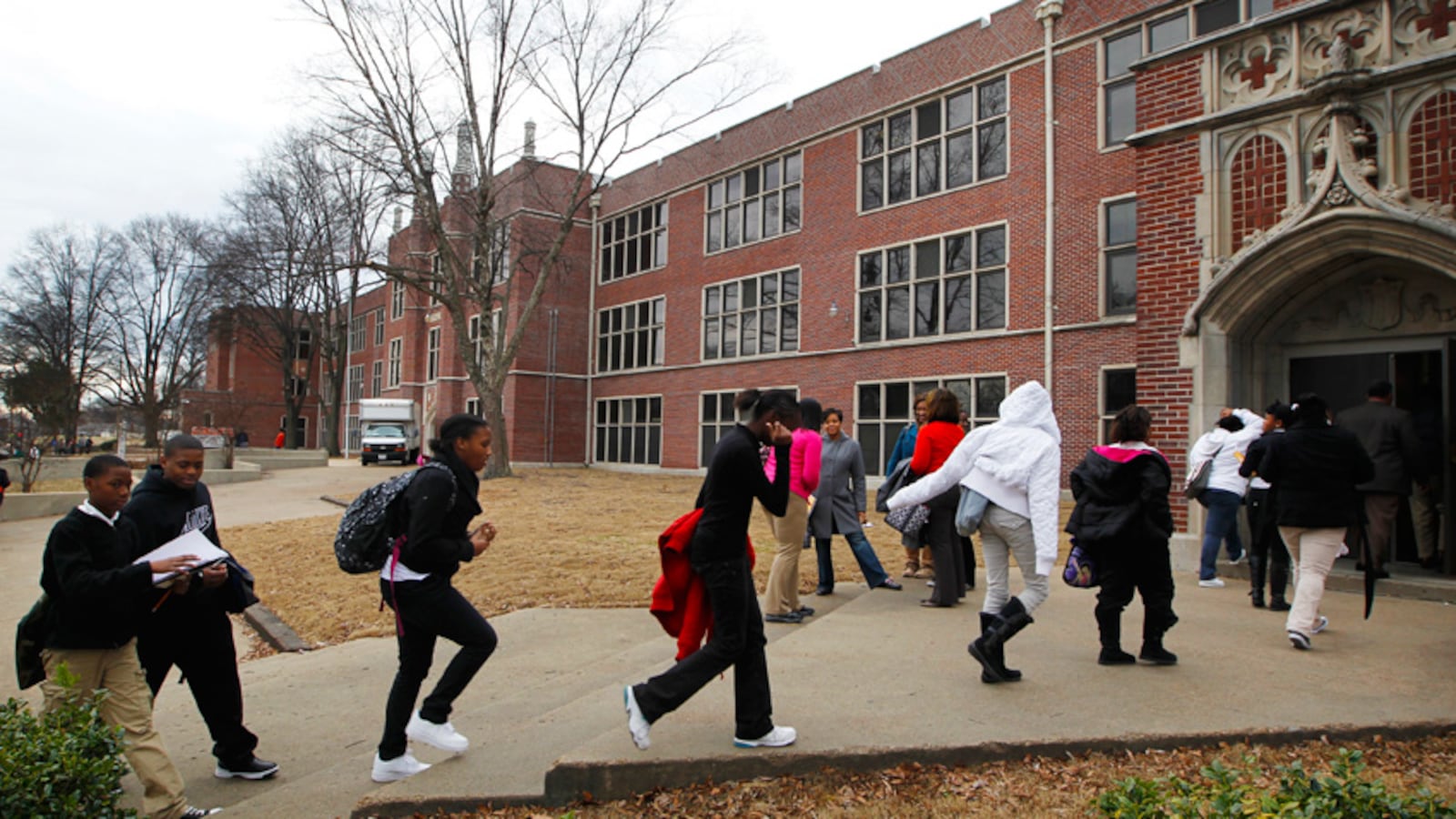More than one in four children in Tennessee’s state-run turnaround district were chronically absent from school last year. Until recently, Armani Fleming, an eighth-grader in Memphis, risked being among them.
Armani struggled with attendance until a student support specialist with Communities in Schools, a Memphis nonprofit focused on wrap-around services for children, worked with him to identify and resolve barriers keeping him from class at Humes Middle School, apart of the Frayser Community Schools charter network.
“I realized Mr. B really cared about me, and he’s helped me make sure I come,” Armani said of the support specialist, Cadarius Buckingham. “He’s more of a counselor to me. I come and talk to him about everything, he’s the person I come to when I need help … and me coming to school has gotten a lot better.”
In the Achievement School District, getting kids to show up at school matters. Recent research has shown that when students have more “familiar faces” around them in class, they’re less likely to be chronically absent. Which is why nonprofits like Communities in Schools are sending staff members into local schools to connect with students like Armani.
Tennessee created the Achievement School District in 2012 to fix its lowest-performing schools by turning them over to charter organizations, but it has struggled to move the needle. Last year, 27.4 percent of the district’s students were chronically absent — representing a 2.4 percent drop from the previous year, but still alarmingly high. Now composed of 30 schools, the district faces higher rates of student mobility and poverty, contributing to its challenges with absenteeism.
Statewide, more than 13 percent of students are chronically absent, defined as having missed 10 percent of the school year, which is typically 18 or more days, for any reason (including excused absences and suspensions), but the average rate was significantly higher, 21 percent, for students who live in poverty.
The stakes are high for improving attendance numbers. Chronic absenteeism is now a major part of Tennessee schools are held accountable by the federal government. And research shows that children who are chronically absent from school are often academically below grade-level, more likely to drop out of school, and more frequently involved in the criminal justice system.
Communities in Schools is now in 19 Memphis schools, eight of them state-run. Those schools have seen, on average, a 5 percent reduction in chronic absenteeism, according to Michael Russom, the group’s director of operations and communications.
One school, Cornerstone Prep Denver Elementary, saw even more dramatic results: an 18 percent drop in chronic absenteeism year-over-year. Last year, just 13.7 percent of the school’s students were chronically absent.
What made the difference? Capstone Education Group, the charter school operator that runs Cornerstone schools, has a staff member dedicated to improving attendance and a partnership with Communities in Schools, said Drew Sippel, executive director of Capstone, which runs two state-run schools in addition to Denver that also had low absenteeism numbers.
“Whenever a parent expresses some concern related to regular attendance, [Patricia] Burns works to resolve impediments to consistent attendance,” Sippel said of the school’s Manager of Student Information and Business Systems. “These impediments range from transportation, homelessness, and inability to purchase school uniforms.”
Untreated health issues is sometimes another factor.
Denver Elementary’s principal also worked with Capstone staff to increase the number of meetings with parents, and therefore, to pinpoint the root causes of students’ absences.

“There’s often an assumption or judgment with parents, ‘Why don’t you just make your kids go to school?’” said David Jordan, CEO of Agape, a Christian nonprofit that has also seen success in reducing chronic absences in Memphis schools. “We keep data on this, and it’s not that parents don’t care. There’s a lot of issues that can prevent students from making it to class.”
The program has grown every year from when it began in 2013 with 113 students. Now, more than 550 students are a part of Agape programs in 16 schools throughout Memphis — and all students they work with are now at school for at least 85 percent of the school year. This is just shy of the group’s goal for Agape students: to attend more than 90 percent of the year.
For its part, Communities in Schools hopes to expand onto additional Memphis campuses, but for now, the focus is the schools they are already serving. And they have added additional staff to some of the highest-needs schools.
One such school is Fairley High School, an Achievement District school run by the charter operator Green Dot Public Schools. There, about 56 percent of students were chronically absent last year, a 19 percent increase from 2017. Russom said they placed two full-time support specialists within Fairley earlier this school year.
Last year, absences spiked at Fairley amid a change of leadership at the school, and it took time for the new principal to gain students’ trust, said Zachary Samson, Green Dot’s area superintendent.
“That’s one huge piece of chronic absenteeism that’s hard to quantify,” Samson said. “It makes such a difference when a student walks in the door, and I as a school leader am able to greet them by name. I know their mom. It’s students feeling seen and appreciated.”
To improve attendance, Samson said his staff is working with Communities in Schools to create an incentive program for students, in which students who meet their attendance goals can attend school parties. He added that they are also focusing on their communication with parents, as many parents may not be aware their children are chronically absent or of the consequences.
Samson said he’s confident attendance can improve at Fairley because he’s seen it happen at another Green Dot school – Wooddale Middle School. About 15 percent of students were chronically absent at Wooddale last year, a drop of 3 percent from the previous school year.
Communities in Schools has a full-time staff member at Wooddale, and that has made an enormous difference, Samson said, noting: “For schools where budgets are very, very tight, having another passionate educator in your school whose big focus is to address attendance and behavior with students – that’s a huge help.”
Update: This story has been updated to clarify that the state defines chronic absenteeism as missing 10 percent of attended school days, which is typically 18 or more days for the school year.
Correction: This story has been corrected to say that one in four students in the Achievement School District were chronically absent last school year, not one in three.

